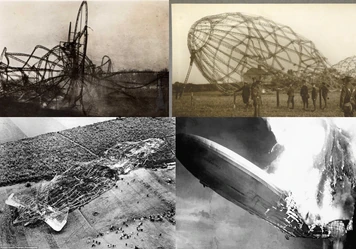The following is a list of all airship fires in history due to hydrogen being a flotation source.

List[]
- LZ-4 (August 5, 1908)
- LZ-6 (September 14, 1910)
- LZ-12/Z-III (June 17, 1912)
- LZ-10 Schwaben (June 28, 1912)
- Akron (July 2, 1912)
- LZ-18/L-2 (October 17, 1913)
- LZ-30/Z-XI (May 20, 1915)
- LZ-40/L-10 (September 3, 1915)
- SL-6 (November 10, 1915)
- LZ-52/L-18 (November 17, 1915)
- LZ-31/L-6 and LZ-36/L-9 (September 16, 1916)
- LZ-53/L-17 and LZ-69/L-24 (December 28, 1916)
- SL-9 (March 30, 1917)
- LZ-102/L-57 (October 7, 1917)
- LZ-87/LZ-117, LZ-94/L-46, LZ-97/L-51, and LZ-105/L-58 (January 5, 1918)
- LZ-104/L-59 (April 7, 1918)
- Wingfoot Air Express (July 21, 1919)
- R-38/ZR-II (August 23, 1921)
- Roma (February 21, 1922)
- Dixmude (December 21, 1923)
- R101 (October 5, 1930)
- LZ-129 Hindenburg (May 6, 1937)
Description of Accidents[]
LZ-4 (August 5, 1908)[]
After an emergency landing near Echterdingen, Germany, LZ-4 was torn from its temporary mooring by a gust of wind and ignited after hitting a stand of trees.
LZ-6 (September 14, 1910)[]
LZ-6, owned by the world’s first passenger airline, DELAG, was destroyed at Baden-Oos by a hydrogen fire which began when a mechanic used petrol to clean the ship’s gondola.
LZ-12/Z-III (June 17, 1912)[]
LZ-12 ignited and burned in its hangar at Friedrichshafen while being deflated.
LZ-10 Schwaben (June 28, 1912)[]
The passenger airship Schwaben was destroyed by fire at the airship field at Dusseldorf when its hydrogen was ignited by static electricity from the ship’s rubberized fabric gas cells.
Akron (July 2, 1912)[]
Melvin Vaniman’s airship Akron exploded 15 minutes after departing Atlantic City, New Jersey, during an attempt to cross the Atlantic.
LZ-18/L-2 (October 17, 1913)[]
An in-flight engine fire ignited the ship’s hydrogen, killing all aboard.
LZ-30/Z-XI (May 20, 1915)[]
The ship broke away from its ground crew after being damaged during removal from its hangar; it crashed nearby and was destroyed when its hydrogen ignited.
LZ-40/L-10 (September 3, 1915)[]
L-10 was destroyed by a hydrogen fire during a thunderstorm near Cuxhaven as it was returning to its base at Nordholz. It is likely the ship rose in an updraft and released hydrogen which was ignited by the atmospheric conditions. All 19 members of the crew were killed.
SL-6 (November 10, 1915)[]
SL-6 exploded and burned on takeoff, killing all aboard.
LZ-52/L-18 (November 17, 1915)[]
The ship caught fire and was destroyed while being refilled with hydrogen at the Zeppelin base at Tønder.
LZ-31/L-6 and LZ-36/L-9 (September 16, 1916)[]
Both ships were destroyed by fire in their hangar at Fuhlsbuttel when hydrogen was ignited during refilling operations.
LZ-53/L-17 and LZ-69/L-24 (December 28, 1916)[]
While L-24 was being returned to the shed it shared with L-17 at Tønder, a gust of wind lifted the ship into the roof of the shed; a light bulb ignited a hydrogen fire which destroyed both ships.
SL-9 (March 30, 1917)[]
SL-9 burned after being struck by lightning in flight over the Baltic, killing all 23 persons aboard.
LZ-102/L-57 (October 7, 1917)[]
L-57 burned in its shed at the airship base of Niedergörsdorf” Juterbog after being damaged by high winds during docking operations.
LZ-87/LZ-117, LZ-94/L-46, LZ-97/L-51, and LZ-105/L-58 (January 5, 1918)[]
An explosion at the Zeppelin base at Ahlhorn ignited the hydrogen of all four ships.
LZ-104/L-59 (April 7, 1918)[]
L-59 exploded in flight and crashed at sea near Malta, killing all 21 members of the crew. L-59 was the famous “Africa Ship” which proved the feasibility of intercontinental zeppelin travel by carrying 15 tons of cargo and 22 persons on a record-breaking 4,225-mile flight during a military relief mission to German East Africa in November 1917.
Wingfoot Air Express (July 21, 1919)[]
Goodyear’s Wingfoot Air Express ignited in mid-air and crashed through the skylight of the Illinois Trust & Savings Building in Chicago, Illinois, killing three persons on the ship and ten bank employees and injuring another 27 people. All subsequent Goodyear airships were inflated with helium.
R-38/ZR-II (August 23, 1921)[]
The British-built R-38 (intended to serve as the United State Navy airship ZR-II) suffered in-flight structural failure over the city of Hull, England and crashed into the River Humber where it ignited, killing 44 of the 49 men aboard.
Roma (February 21, 1922)[]
The United States Army airship Roma (built by Umberto Nobile) ignited when it hit high-tension electrical wires near Langley Field at Hampton Roads, Virginia, killing 34 of the ship’s 45 crew members. After the Roma disaster, the United States government decided never again to inflate an airship with hydrogen.
Dixmude (December 21, 1923)[]
he French-operated Dixmude was destroyed over the Mediterranean Sea near the coast of Sicily by a hydrogen explosion visible from miles away. Dixmude’s gas cells had apparently been contaminated with air, creating an explosive mixture, and the ship may have been lifted by updrafts in a thunderstorm, causing hydrogen to be vented and then ignited by the electrically charged atmosphere.
R101 (October 5, 1930)[]
The poorly-designed British R101 lost altitude and sank into a hillside near Beauvais, France. The impact was slight and caused few if any injuries, but the ship’s hydrogen ignited and the ensuing inferno killed 48 of the 55 passengers and crew.
LZ-129 Hindenburg (May 6, 1937)[]
Hindenburg was destroyed by a hydrogen fire at the Lakehurst Naval Air Station.